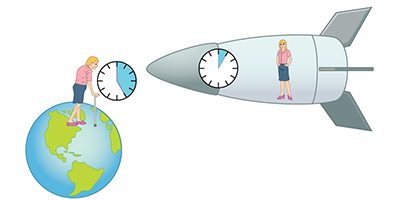September 19, 2014 report
Experiment with speeding ions verifies relativistic time dilation to new level of precision

(Phys.org) —A team of researchers working at the Experimental Storage Ring in Damstadt, Germany have conducted an experiment using ions pushed to 40 percent of the speed of light to verify time dilation to a new level of precision. In their paper published in Physical Review Letters, the team describes how their experiment was conducted and how it allowed them to validate the time dilation prediction to just a few parts per billion.
When Einstein came up with his theories on special relativity, the world was introduced to the idea of measuring time dilation—where an astronaut would age at a different rate than those left behind on Earth—due to the speed of light being a constant. Relativistic time dilation comes from the Lorentz invariance, which says that no matter where in the universe an object is, or at what speed it might be traveling, the rules remain the same. Since Einstein's time, scientists have conducted many experiments to prove the theory true—some by using natural objects such as the movement of the Earth in relation to other celestial bodies—others by conducting experiments in the lab.
Such experiments have proven successful and today, the idea of measuring time dilation is more about precision than adding proof that the theory is correct. In this latest effort, the team working in Germany caused ions to move very fast using an accelerator, then fired lasers in opposite directions to look for and measure the relativistic Doppler shift as it occurred. As part of the experiment, the researchers used a new technique to keep the relative velocity of all the ions very low, and another involving optical-optical double resonance spectroscopy to detect very small changes in brightness.
The experiment allowed for measuring the shift in laser frequencies relative to what the transition frequencies would be for ions that had not been accelerated. By combining the two frequency shifts, uncertainties could be eliminated making it possible to validate time dilation predictions to an order of precision much higher than previous limits. It also demonstrated that it's possible to improve time dilation measurement precision in a lab, which means that scientists no longer have to rely on celestial bodies, which tend to come along with assumptions that may or may not be based on actual facts.
More information: Test of Time Dilation Using Stored Li+ Ions as Clocks at Relativistic Speed, Phys. Rev. Lett. 113, 120405 – Published 16 September 2014. journals.aps.org/prl/abstract/ … ysRevLett.113.120405
Journal information: Physical Review Letters
© 2014 Phys.org




















